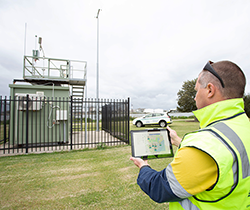Real time data and technology for engaging on air quality
We work closely with our environment department colleagues, who run the State’s air quality monitoring network, to respond to issues affecting air quality. As we move into summer it’s timely to remind our community how to access this data and report on air pollution.

The EPA helps the NSW air quality monitoring network to provide real-time data.
A new, easier to use and understand air quality website has been launched for anyone to follow recording data from monitoring stations in metropolitan and regional centres including the South Coast, Central West and Hunter Region.
The NSW Government operates Australia’s largest air quality monitoring network – with more than 90 stations providing the community with accurate, up-to-date information on an hourly basis. In the Hunter and Naomi, the public can check air quality from monitors located close to mines on the Department of Planning, Industry and Environment (DPIE) website.
“These air monitoring stations mean we’re able to use real time data. Information is received and analysed on a regular basis and published through air quality monitoring reports ,” Matt Riley Director Climate and Atmospheric Science at DPIE said.
“Through ongoing benchmarking we’re able to see when air pollution is at its lowest and highest. We measure overall air quality, PM10 and PM2.5 particles, ozone, nitrogen dioxide and sulfur dioxide and other elements.
“Our air quality monitoring was incredibly important during the bushfires to alert people with health issues, particularly asthma and heart disease, to times when the air quality was expected to be at its worst.
“The geographic extent, duration and levels of PM2.5 particles* observed simultaneously across many regions during last year’s bushfire season, resulted in the longest severe air pollution event on record for northern, central and coastal areas in NSW,” Matt said.
“The target performance for air quality monitoring from our sensors is for at least 95 per cent of data to be available at all times, for all criteria pollutants and meteorological parameters.”
There are 14 monitoring stations in the Hunter region alone. The EPA-led Upper Hunter Air Quality Advisory Committee and the Newcastle Community Consultative Committee for the Environment with representatives from local government, community and industry, meet to discuss air quality matters, impacts on health and impacts from industry.
“Since the Committees were established, reporting and sharing with the community, what is often complex information, has been refined thanks to their recommendations,” EPA Director Regulatory Operations Adam Gilligan said.
During significant air pollution events like the bushfires, special air quality statements are released. The NSW Air Quality Special Statement Spring–Summer 2019–20 describes the extreme air pollution, smoke and dust in the NSW bushfire season 2019–20.

EPA campaigns like 'Bust the Dust' in the Hunter help to monitor air quality.
Find out more and how to get involved
- Report concerns regarding dust risk directly to the Environment Line on 131 555
- See the dashboard of daily updates
- How to report pollution incidents
- NSW Air Quality Index
- Mine regulation

